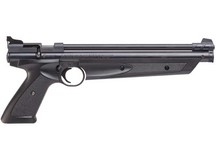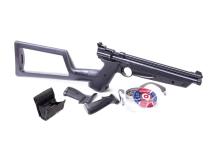Definitive Guide to Crosman 1322
The Crosman 1322 air pistol was introduced in 1977. Crosman discontinued it in 2004 but then reintroduced it in 2012. The basic makeup and construction of the 1322 have stayed the same. The overall construction is cast or stamped metal with plastic parts used in both primary and secondary locations. Let's go through that now.
Let's start with the plastic parts. The grips, pumping handle, front barrel and tube end cap, front sight, cross-block safety, and rear breach are all made from durable plastic. The rest of the Crosman 1322; the barrel, frame, trigger blade, hammer, and valve are all cast metal, aluminum, or brass. Materials may vary based on age and source materials available at the time of manufacture.
The total weight of the Crosman 1322 pellet pistol is two pounds, and the overall length is 13.63 inches. The rifled steel barrel is 10.25 inches. At the front of the barrel is a ramp front sight and at the back is a convertible site that can be configured for use as a pistol, or converted to a peep sight when a carbine stock is used to replace the pistol grips.
Power for the 1322 comes from an integrated pump. The plastic forearm is the pumping handle. The rear bolt needs to be cocked in order for the onboard air cylinder to charge to shooting pressure. The air cylinder is emptied with each shot so shooters will need to pump up the 1322 for each shot. Let's move on to exactly how all this works.
One very important feature of the entire 13xx line of Crosman airguns is their incredible customization options. The Crosman 1322 multi-pump pistol is ideal for shooters that like to tinker and mod their airguns. The number of 3rd party accessories and accessory manufacturers continues to grow each year, especially with the advent of affordable and durable 3D-printed parts.
It may be an assumption on our part, but we feel Crosman has always seen the 1322, and its related variants, as a starting point for modders. They produce their own line of accessories, some of which are very affordable, useful, and easy to install. The most important first upgrade is the steel breach. The steel breech assembly replaces the plastic breech with a more robust steel version that features an 11mm dovetail for attaching optics.
Crosman, along with other companies, offers additional upgrades such as different barrel lengths and makes, i.e., there's a Lother Walther barrel available for those that want a "match" version. There are also adjustable trigger parts, skeleton stocks, hammer spring adjusters, custom wood grips, folding rear stocks, etc. And the list just keeps on going. Of course, it's easy for someone to turn a low-cost starter air pistol into a project costing several hundred dollars. But that's exactly the fun and benefit of the 1322; the options are nearly endless.
Please note: modifying the 1322 in any way could cause harm if done incorrectly and may void any warranties that come with the gun. Modify at your own risk.
The 1322 is a .22 caliber single-shot, bolt-action pellet pistol. There is a .177 version available for those wanting to shoot .177 vs. .22. It's called the 1377 and has the same composition, design, and operation. There will be performance differences due to the different calibers, but it's essentially the same pistol.
Operation begins by engaging the cross-block safety located immediately in front of the trigger guard. Before you can pump up the 1322, you will need to cock the bolt. It's best to leave the bolt open while pumping in case of an accidental discharge. Once you've filled the gun to the desired pressure, more on that later, you can load your pellet and close the bolt. The 1322 is now ready to fire.
To fire, you'll need to move the safety to the fire position, aim the pistol at your intended target, and gently squeeze the trigger. Then, to take another shot, simply repeat the process.
Performance & Accuracy
Before we get to the variable power portion of this guide, let's talk about some other important numbers starting with the trigger pull. The trigger is non-adjustable and breaks at about 4 pounds. It's not a light trigger, and it can feel a bit "gritty." It's the type of trigger you'd expect from a $70 airgun. However, it's easy enough to service, and with a little TLC, it can be made much better and more enjoyable to shoot.
The muzzle report of the 1322 will vary somewhat. It runs between 78 and 84 DB. While you may think that the number of pumps would determine the ultimate volume, we found that each level from 3 to 10 got similar results across several shots. The multi-pump system can use as few as 3 pumps and can take a maximum of 10 pumps. Here are the power output and energy levels for each power setting using the 14.3-grain Crosman Premier Hollow Point pellets.
As you can see, each power level increased fairly consistently, with more noticeable increases near the start of the scale. It's not linear, however. Nevertheless, it does demonstrate the 1322's versatility, going from 2.49 FPE to 6.55 FPE simply by increasing the number of pumps. As a quick note, the energy needed to pump increases slightly with each stroke but, in our opinion, never becomes unreasonable or too tiring.
The Crosman 1322 pistol has always been a very accurate airgun right out of the box. For our tests, we'll be shooting it in its pistol configuration using the open sights. All our 5 shot groups will be shooting from a rest at 12 yards. To demonstrate how the various power levels may affect accuracy, we'll shoot 3 test groups. The first group will use 4 pumps per shot. The second will use 7 pumps, and the final set will be at full power with 10 pumps for each shot. Our results are below.
12 yards - 4 pumps per shot - We tested our 1322 using the open sights with the rear notch. The black bull was sitting on top of the front sight. 4 pumps at 12 yards seems to be right on target.
12 yards - 7 pumps per shot. The rear sight was adjusted as low as possible for our first test. We aimed at the bottle of the outer ring, and the shots landed high.
12 yards - 10 pumps per shot - Our shots were landing very high on max power. Our aim point was well below the point of impact. Regardless, the group was very good.
Summing Up
As you can see, the Crosman 1322 is an affordable, capable pellet pistol. It runs solely on lead and elbow grease, which makes it a popular airgun for those on a tight budget. It's very accurate and has the potential for taking small game and pests at close range. In addition, the volume of upgrade parts allows shooters to start at a very modest $70 and build their airgun masterpiece over time.
Crosman had to bring back the 1322. It's just too good of an airgun to leave sitting on the shelf. If you have questions about the 1322 or Crosman's pellet pistol options, please feel free to give us a call.












